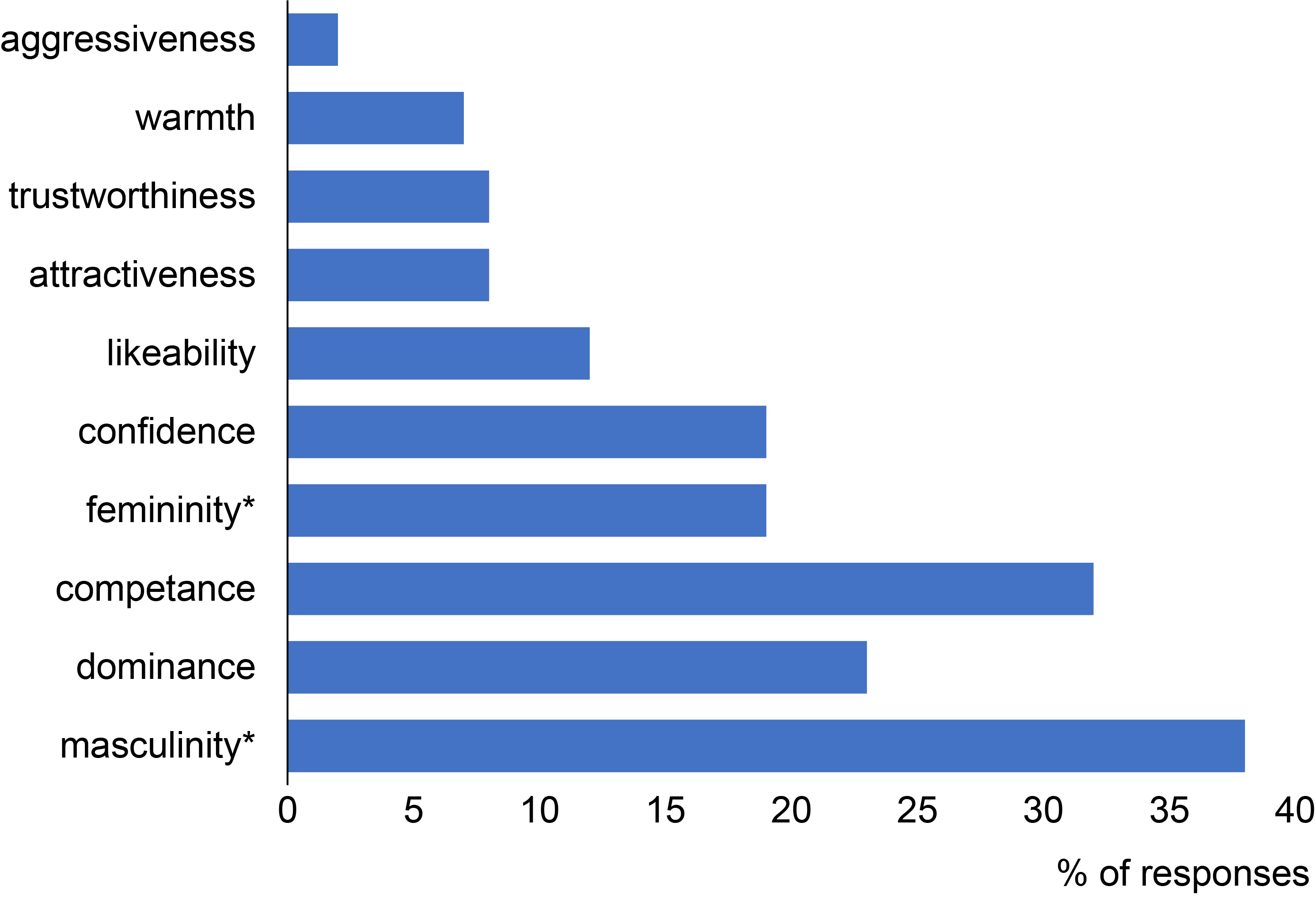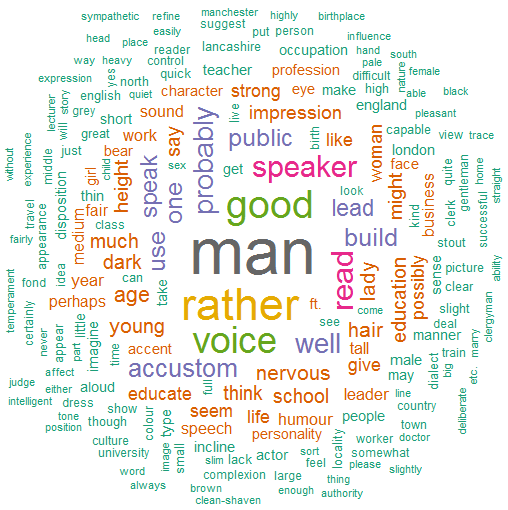In a previous blog I wrote about a remarkable pioneering experiment from the 1920s into how people perceive voices on the radio. What do listeners take from a voice when they can’t see the talker? In the experiment, radio listeners heard nine “mystery voices” reading a short passage from Dickens. (I’ve reproduced their faces below to give you a sense of who was doing the reading, obviously the listeners didn’t have this information!) The audience were then were asked to fill out a questionnaire in The Radio Times, answering some closed questions about each speaker: their sex, age, profession, etc.

I’ve been looking at the ‘general remarks’ people sent in. These are about six-hundred text responses never seems to have analysed by the experimenter Professor Pear. One striking feature of these responses, is that people are incredibly judgmental.
“He has been anything but successful, and has great difficulty in making ends meet. I would imagine him as being tall and cadaverous, round-shouldered, with a long neck and protruding chin, but oh, so sad ; very nervous and lacking confidence.”
Comment on The Reverend Victor Dams
Nowadays, there is a problem with people being spectacularly rude on social media. But Pear’s responses show that this isn’t anything new. I wonder what the “mystery voices” thought about these blunt remarks?
Text mining
In recent years sophisticated text-mining tools have been developed, and I thought I’d see what they would reveal about Pear’s open-text data. In my first blog, I looked at sentiment analysis, below I’m going to explore the common words people used across all voices.
I’m going to compare the words in the old text replies to common terms used in current research. Rather than give respondents free-rein to write anything, most modern researchers tend to get people scoring voices on a set of prescribed scales. It makes experiment design and analysis much easier. Typical scales get people rating voices for, aggressiveness, attractiveness, competence, confidence, dominance, femininity, likeability, masculinity, trustworthiness and warmth. [1] This list actually arose from research into how people judge faces, and then got co-opted to be used for voice research. Are they relevant to Pear’s study and data? This question is going to inform my analysis.
Summary graphs


Femininity, Masculinity
“Man” is the most common word used by Pear’s respondents as the word cloud shows. But where is “woman”? It’s there top-right in the word cloud, but it was used much less frequently. This happens because there are a number of different gender labels for females. The speaker Miss Pear was described most often as a “girl”, Miss Ree as a “lady” and Miss Robinson as a “woman”. As multiple terms are used for the females, these aren’t as prominent in the word cloud. The difference in percentage for masculinity and femininity in the bar chart (Fig 3) reflects the fact there were twice as many male speakers as female.
For each of the speakers, the most common term used describes the gender of the person. The difference in pitch between male and female voices is an example of sexual dimorphism, a characteristic designed to signal your gender. There is usually a clear audible difference between men and women, and hence it isn’t surprising that gender terms featured strongly in responses.
Dominance
“The speaker is not a leader of men, but he compels people to obey him”
Comment on Mr George Grossmith
“If a leader, it is by quiet sympathy”
Comment on Miss A L Robinson
About a quarter of responses mentioned a synonym or antonym of dominance. The majority of those seem to be a commentary on the leadership ability of the speaker. As the questionnaire in the Radio Times specifically asked about leadership in a closed question, maybe this prompted people to comment about this in their general remarks. I was surprised how common dominance words appeared.
Competence and Confidence
“The speaker sounded a typical London typist, quick in action, though rather slow in reading, with a remarkable ability for getting the meaning out of the passage read.”
Comment on Miss Marjorie Pear
“Was rather difficult to follow; he read very quickly, and his muffled voice suggested an indoor worker, in a wool factory.”
Comment on Mr H Cobden Turner
The quality of the reading by the speakers features in about a quarter of responses. This makes it difficult to separate out competence and confidence, because they can both be used to describe the quality of a speaker’s performance. You can see terms like read, good, well, public speaking, confidence and nervous in the word cloud. As I noted in my first blog, the naive talkers were unrehearsed and doing a live reading on national radio, maybe this is why performance quality varied and so features prominently.
A concept closely related to competence was the level of education portrayed by the voice. This attracted comment in about a seventh of responses. Here is an example,
“A fat man, little schooling, age, say, 55 ; possibly a policeman-perhaps rather too uneducated, though the monotonous, stilted speech sounds like a rural policeman.”
Comment on Detective-Sergeant F R Williams
Over a third of answers related to occupation (like the one above). Some of these might be read as a judgement on competence if the job requires that, but other characteristics such as likeability and trustworthiness could also play a role in the suggested occupation. This illustrates why researchers tend to use scales when people are making judgements on voices. Trying to work out how a suggested occupation might relate to something like trustworthiness is fraught with difficulty. Take science as an example. It is well documented that Americans’ Trust In Scientists Splits Along Partisan Lines, with 54% of Democrats but only 13% of Republicans, having “a lot” of trust in the accuracy of what scientists.
Aggressiveness
“Gave himself away by unconsciously using his evidently habitual, scolding, hectoring voice, with nasty twang (I don’t mean accent), I mean viciousness. There was nothing in the passage at all calling for that feeling. He, I am sure, is given to ranting and stirring up strife, a most bullying, unpleasant person”
Comment on Detective-Sergeant F R Williams
An amusing quote, but in reality terms relating to aggressiveness only featured in about 2% of the responses. This must have been influenced by the passage the mystery voices were asked to read. They text was about Mr Winkle’s comical attempts at ice skating from Dicken’s The Pickwick Papers. This illustrates the strong interaction between our perception of voice and the words that people are saying.
Attractiveness & Likeability
“Probably rather big and burly, with straight brownish hair, blue eyes, clean-shaven, with a pink face.”
Comment on Detective-Sergeant F R Williams. Looking at the photo of the Detective-Sergeant, he certainly isn’t ‘big and burly’
While there were a relatively small number of comments about attractiveness (8% of responses), there are plenty of words that describe appearance: clean-shaven, slim, complexion, thin, fair, short, hair, stout, eyes etc. This is fascinating because most of these attributes have no influence on peoples’ voices. It’s hard to see a direct way the colour of your eyes is going to influence your voice, for example. Whether a man is clean-shaven or has a beard doesn’t change how they sound!
Why do people describe someone’s appearance when they can’t possibly know what they look like for real? Listeners conjure up an image of the talkers in their head, and these naturally include visual elements. After all, conjuring up a caricature is a useful short-hand to help you remember a talker. See my book Now You’re Talking for more on this.
Some characteristics like height do have some influence on the voice. Children tend to be shorter than adults, and children have higher pitched voices. But within broad categories like ‘adult males’, the effect of height on voice is relatively small. Misconceptions like this are really common with the voice.
Likeability
“A sweet, elderly voice. ‘The Angel in the House’”
Comment on Miss A L Robinson
“An altogether cold, unwelcome voice”
Comment on Miss A L Robinson
These two quotes jumped out of me when looking at examples of the 12% of responses that commented on likeability. It is hard to believe this is a judgement about the same person given their opposing opinions! I get a sense that contradictory opinions of the same speaker are quite common, but I’ve not worked out a clever way of testing that via text-mining. If you’ve got any ideas, please comment below.
Finally
While the terms aggressiveness, attractiveness, competence, confidence, dominance, femininity, likeability, masculinity, trustworthiness and warmth capture much of the voice, there are additional features that come out of free text responses. Occupation is one example from above, but others would be the many comments on where a person comes from (22% of responses), their accent (7%) and class (8%). The figure below shows words that were used near the word “voice” in responses. I was trying to narrow down what words related to vocal quality. I’ll leave you to puzzle over what this might mean, and to comment below.

Appendix: Detailed method
This last bit is for those interested in how this was done in detail. To get the keywords the text responses from Pear’s book were scanned and converted to text using an OCR. The subsequent processing was then done in R. The sentences were cleaned up: punctuation was removed and common words that are unlikely to be useful for the analysis removed (e.g. ‘and’). Lemmatization was applied to ground words of similar meaning (e.g. ‘studies’ and ‘studying’), with the words shown being the shortest lemma (e.g. ‘study’). Counting occurrences of the lemmas than enabled the word cloud (Fig 2) to be constructed. Fig 2. only has words appearing at least 5 times, with a maximum number of 200 words in the cloud.
Fig 4. was formed by splitting the responses into sentences and using only those that had “voice” within them. Words that weren’t very useful for analysis like “rather” were removed. Only words used in at least two responses are shown.
Fig. 3. shows the percentage of terms (including synonyms and antonyms). This was constructed as follows. Synonyms and antonyms were taken from Thesaurus.com using the most common ones. Respondents were then searched word using stemming. Fig 3. was updated on 2/4/19 because some of the numbers were slightly wrong.
References
[1] McAleer, P., Todorov, A. and Belin, P., 2014. How do you say ‘Hello’? Personality impressions from brief novel voices. PloS one, 9(3), p.e90779.
Follow me
3 responses to “More on Voice and Personality”
To me, what is surprising (or maybe not) is the scarcity of words that really describe the sonic properties of those voices (e.g., sweet, dark, bright, nasal, deep, trembling, breathy,etc.).
A really good point. I remember seeing dark. I’ll hunt for voice adjectives
[…] ← More on Voice and Personality […]